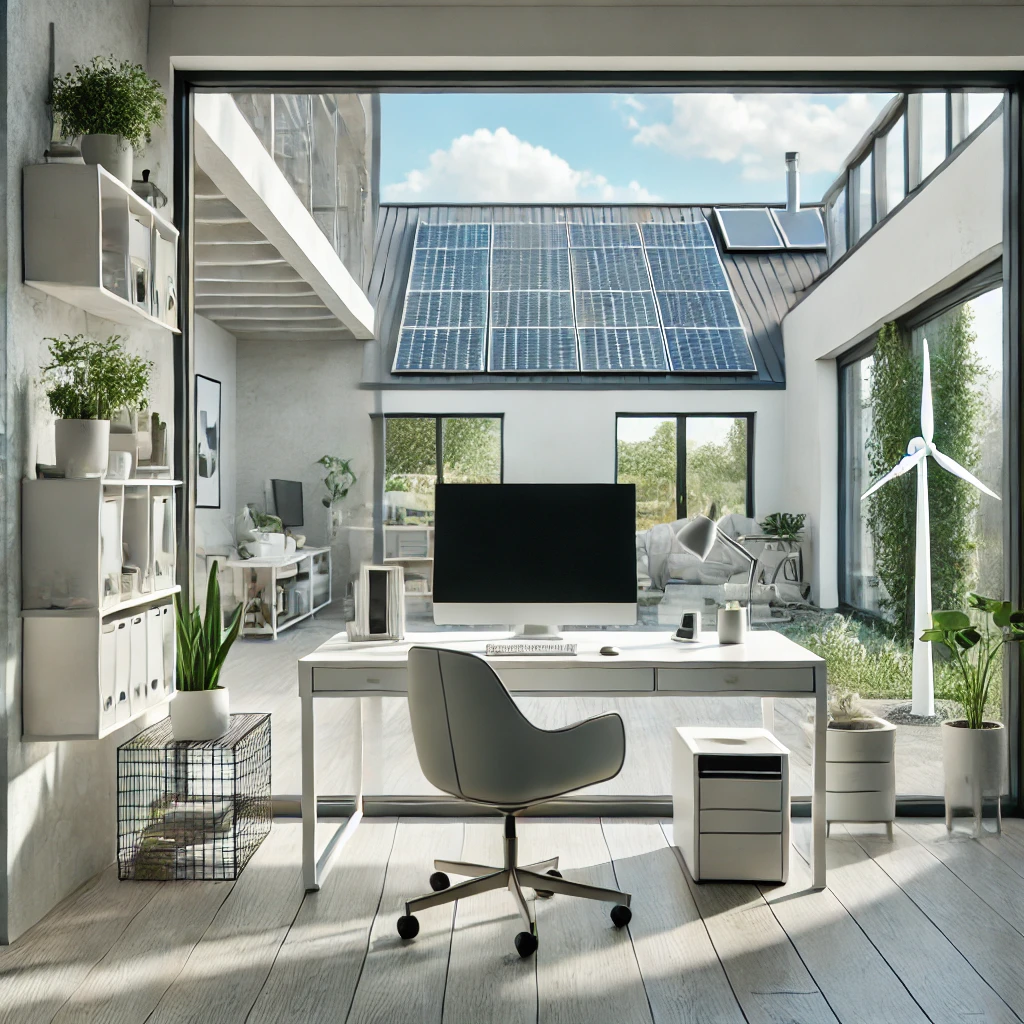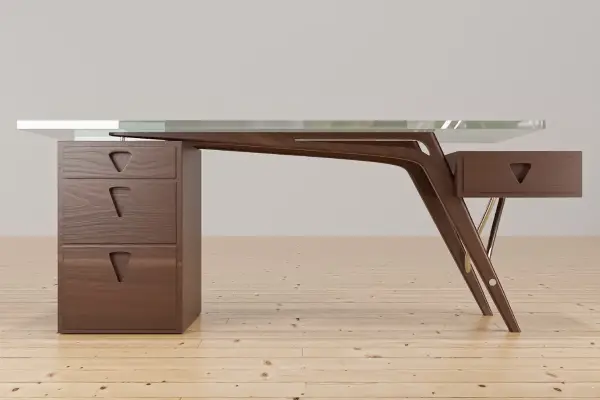Minimalist home office design focuses on creating a clean, uncluttered, and functional workspace. It emphasizes simplicity, where every item serves a purpose and contributes to a serene and efficient environment. The minimalist approach eliminates unnecessary distractions, allowing you to concentrate better and maintain a clear mind, ultimately enhancing productivity and creativity.
Importance of Lighting in Creating an Effective and Aesthetic Workspace
Lighting plays a crucial role in any home office, particularly in a minimalist setting. It’s not just about illuminating the space; it’s about creating the right ambiance, reducing eye strain, and enhancing the overall aesthetic appeal of the office. Proper lighting can transform a simple room into a dynamic workspace, boosting your mood and productivity while maintaining the minimalist principles of simplicity and functionality.
Purpose of the Article
This article aims to guide you on how to effectively use lighting to enhance your minimalist home office. We will explore the principles of minimalist lighting design, the different types of lighting, and how to choose the right fixtures. Additionally, we will provide practical tips on the placement and arrangement of lighting, maximizing natural light, and integrating smart lighting solutions. By the end of this article, you’ll have a comprehensive understanding of how to create a well-lit, stylish, and functional minimalist home office that meets your needs.
The Role of Lighting in Minimalist Design
Definition and Principles of Minimalist Lighting
Minimalist lighting focuses on simplicity, functionality, and clean lines. It emphasizes the use of essential elements to create an uncluttered and serene environment. In a minimalist home office, lighting plays a crucial role in highlighting the simplicity and elegance of the space while ensuring it remains practical and comfortable for work.
The principles of minimalist lighting include:
Simplicity: Avoiding overly ornate or complex fixtures. Opting for straightforward designs that blend seamlessly with the overall decor.
Functionality: Ensuring that each lighting fixture serves a specific purpose, whether it’s providing general illumination, task lighting, or accentuating architectural features.
Clean Lines: Choosing fixtures with sleek, unobtrusive designs that complement the minimalist aesthetic.
Subtlety: Incorporating lighting that enhances the space without drawing unnecessary attention to itself.
How Lighting Influences Mood and Productivity
Lighting has a profound impact on mood and productivity, making it an essential component of any home office. Proper lighting can help reduce eye strain, improve focus, and create a more inviting and motivating work environment. Here’s how different types of lighting influence your workspace:
Natural Light: Exposure to natural light has been shown to boost mood, energy levels, and overall well-being. It helps regulate circadian rhythms, which can enhance alertness and productivity during the day.
Cool Light: Cool white light (around 4000K-5000K) mimics daylight and is ideal for tasks that require attention to detail and concentration. It can help you stay focused and alert, making it perfect for work-related activities.
Warm Light: Warm light (around 2700K-3000K) creates a cozy and relaxing atmosphere. While not ideal for task lighting, it’s great for accent lighting and can help create a soothing environment for brainstorming or unwinding after work.
The Aesthetic and Functional Balance in Minimalist Design
In minimalist design, achieving a balance between aesthetics and functionality is key. Lighting should not only look good but also serve its intended purpose effectively. Here are some tips to strike this balance:
Layering Lighting: Use a combination of ambient, task, and accent lighting to create a versatile and well-lit space. This approach allows you to adjust the lighting according to your needs and activities.
Choosing the Right Fixtures: Select fixtures that complement the minimalist aesthetic of your office. Look for designs that are sleek, simple, and unobtrusive, yet capable of providing sufficient illumination.
Optimizing Light Placement: Position lighting sources strategically to enhance the functionality and visual appeal of your office. Ensure that task lighting is placed where it’s needed most, and use accent lighting to highlight key features or areas.
By understanding the role of lighting in minimalist design, you can create a home office that is both aesthetically pleasing and highly functional. The next section will explore the different types of lighting and how to incorporate them into your minimalist workspace.
Types of Lighting
Ambient Lighting
Definition and Purpose: Ambient lighting, also known as general lighting, provides overall illumination for a room. It ensures that the entire space is evenly lit, creating a comfortable and welcoming environment.
Examples and Recommendations:
Ceiling Lights: Simple, flush-mounted ceiling fixtures or recessed lights can offer ample ambient lighting without drawing attention away from the minimalist decor.
Pendant Lights: Sleek pendant lights can provide ambient lighting while adding a touch of style. Choose designs with clean lines and neutral colors.
Wall Sconces: These can be used to provide general lighting, especially in smaller offices. Select sconces that complement the minimalist aesthetic of your space.
Task Lighting
Definition and Purpose: Task lighting is focused on illuminating specific work areas, such as desks or reading nooks, to help you perform tasks that require attention to detail. It reduces eye strain and improves productivity.
Examples and Recommendations:
Desk Lamps: Opt for minimalist desk lamps with adjustable arms or heads to direct light exactly where you need it. LED desk lamps with dimmable settings are a great choice for their efficiency and flexibility.
Under-Cabinet Lights: If you have shelves or cabinets above your workspace, consider installing under-cabinet lights. They provide direct light to your desk area without cluttering the surface.
Floor Lamps: For a minimalist office, choose a floor lamp with a slim profile and simple design. Place it next to your desk or reading chair to provide focused light.
Accent Lighting
Definition and Purpose: Accent lighting highlights specific features or areas in a room, adding depth and dimension to your minimalist office. It can be used to draw attention to artwork, architectural elements, or decorative objects.
Examples and Recommendations:
Track Lighting: Adjustable track lighting can be used to highlight artwork or shelves. Choose a track system with a minimalist design and sleek fixtures.
Wall Washers: These lights are designed to cast light across a wall, creating a soft, even glow that can enhance the texture and color of your walls.
Spotlights: Small, unobtrusive spotlights can be strategically placed to highlight specific features, such as a plant or a piece of art. Look for spotlights with adjustable heads for versatility.
By understanding and incorporating these three types of lighting, you can create a well-balanced and functional lighting scheme for your minimalist home office. Each type of lighting serves a specific purpose and contributes to the overall aesthetic and usability of the space. The next section will guide you on choosing the right lighting fixtures to align with your minimalist design principles.
Choosing the Right Lighting Fixtures
Simple and Sleek Designs
In a minimalist home office, the design of your lighting fixtures should reflect the principles of simplicity and elegance. Here’s how to choose fixtures that align with this aesthetic:
Minimalist Aesthetics: Opt for fixtures with clean lines, geometric shapes, and minimal embellishments. Avoid overly decorative or intricate designs that can disrupt the minimalist flow.
Monochromatic Color Schemes: Stick to neutral colors such as white, black, gray, or metallic tones. These colors blend seamlessly into a minimalist environment without drawing too much attention.
Matte Finishes: Choose fixtures with matte finishes to reduce glare and create a more subtle, understated look.
Neutral Colors and Materials
The materials and colors of your lighting fixtures play a crucial role in maintaining a cohesive minimalist design:
Natural Materials: Consider fixtures made from natural materials like wood, metal, or glass. These materials add texture and interest without overwhelming the space.
Consistent Palette: Ensure that your lighting fixtures complement the color palette of your office. Neutral and earthy tones work well in minimalist spaces, creating a harmonious and balanced look.
Integrated Designs: Look for fixtures that integrate well with the existing decor. For example, a sleek metal lamp can complement a modern metal desk or shelving unit.
Energy Efficiency Considerations
Sustainability is an important aspect of minimalist design. Choosing energy-efficient lighting options not only benefits the environment but also enhances the functionality of your workspace:
LED Bulbs: LED bulbs are highly energy-efficient and have a longer lifespan compared to traditional incandescent bulbs. They come in various color temperatures, allowing you to choose the right light for your office needs.
Smart Lighting: Smart lighting systems can be controlled remotely and programmed to adjust according to your schedule, reducing energy consumption and providing convenience.
Dimmable Lights: Installing dimmable lights allows you to adjust the brightness according to the time of day and task at hand, creating a flexible and energy-efficient lighting setup.
Examples of Minimalist Lighting Fixtures
Here are some examples of lighting fixtures that embody minimalist principles and can enhance your home office:
Recessed Lighting: Ideal for ambient lighting, recessed lights are unobtrusive and blend seamlessly into the ceiling, providing a clean and modern look.
Pendant Lights: Simple pendant lights with geometric shapes and neutral colors can serve as both ambient and task lighting, adding a touch of elegance to your office.
Adjustable Desk Lamps: Sleek, adjustable desk lamps with LED bulbs offer precise task lighting while maintaining a minimalist design.
Wall Sconces: Minimalist wall sconces with clean lines and matte finishes provide ambient or accent lighting without taking up floor or desk space.
Track Lighting: Modern track lighting systems with adjustable heads can highlight specific areas or objects in your office, adding depth and interest.
By choosing the right lighting fixtures, you can enhance both the aesthetic appeal and functionality of your minimalist home office. The next section will delve into the placement and arrangement of these fixtures to create a balanced and well-lit workspace.
Placement and Arrangement of Lighting
Tips for Strategic Placement of Lighting Sources
Strategic placement of lighting is essential in a minimalist home office to ensure that the space is well-lit and aesthetically pleasing. Here are some tips to help you achieve this:
Layer Your Lighting: Use a combination of ambient, task, and accent lighting to create a versatile and well-lit space. Layered lighting allows you to adjust the light levels according to different tasks and times of the day.
Avoid Overcrowding: In a minimalist office, less is more. Avoid placing too many light fixtures in one area. Instead, focus on positioning a few well-chosen lights strategically to illuminate the entire space.
Utilize Corners and Edges: Placing floor lamps or wall sconces in the corners or along the edges of the room can help distribute light evenly and create a sense of spaciousness.
Balancing Natural and Artificial Light
Balancing natural and artificial light is crucial for creating a harmonious and productive workspace:
Maximize Natural Light: Position your desk near a window to take advantage of natural light during the day. Natural light not only reduces the need for artificial lighting but also boosts mood and productivity.
Use Sheer Curtains: Sheer curtains can diffuse harsh sunlight while still allowing plenty of natural light to enter the room. They also add a soft, minimalist touch to the decor.
Supplement with Artificial Light: When natural light is insufficient, use artificial lighting to fill in the gaps. Make sure your artificial light sources mimic the quality and color temperature of natural light for a seamless blend.
Layering Different Types of Lighting
Layering different types of lighting creates a dynamic and functional lighting scheme:
Ambient Lighting: Install ceiling lights or recessed lights to provide general illumination. This will ensure the entire room is evenly lit.
Task Lighting: Add desk lamps, floor lamps, or under-cabinet lights to specific work areas where focused light is needed. Adjustable lamps are particularly useful for directing light exactly where you need it.
Accent Lighting: Use spotlights, track lighting, or wall sconces to highlight artwork, plants, or architectural features. Accent lighting adds depth and visual interest to your office.
Creating Focal Points with Lighting
Lighting can be used to create focal points that draw the eye and add interest to a minimalist office:
Highlight Key Areas: Use accent lighting to draw attention to key areas of your office, such as a bookshelf, a piece of art, or a plant. This adds depth and dimension to the space without cluttering it.
Use Statement Fixtures: A single statement light fixture, such as a unique pendant light or a designer desk lamp, can serve as a focal point. Choose a fixture that complements the minimalist aesthetic while standing out as a design element.
Play with Shadows and Light: The interplay of shadows and light can create a dramatic and visually appealing effect. Use adjustable lighting to create interesting patterns and textures on the walls or ceiling.
By carefully considering the placement and arrangement of your lighting sources, you can create a balanced, functional, and aesthetically pleasing minimalist home office. The next section will discuss how to enhance natural light to further improve your workspace environment.
Enhancing Natural Light
Maximizing the Use of Windows and Skylights
Natural light is a cornerstone of minimalist design, providing a bright and airy atmosphere that enhances productivity and well-being. Here’s how to make the most of your windows and skylights:
Positioning: Place your desk near a window to take full advantage of daylight. If possible, orient your workspace so that natural light comes from the side, reducing glare on screens.
Skylights: If your office is in a location where installing skylights is an option, they can be a fantastic source of natural light. Skylights provide even, overhead light that can brighten the entire space without taking up wall space.
Window Size and Placement: Large windows or floor-to-ceiling windows maximize natural light. If you’re planning a renovation or designing a new office, consider the size and placement of windows to optimize light flow.
Using Reflective Surfaces to Amplify Natural Light
Reflective surfaces can help distribute natural light throughout your office, making the space feel larger and brighter:
Mirrors: Strategically place mirrors to reflect light into darker areas of the room. A large mirror opposite a window can double the amount of natural light.
Glass and Glossy Finishes: Furniture and decor with glass or glossy finishes can help bounce light around the room. Consider a glass desk, glossy white cabinets, or shiny metallic accessories.
Light-Colored Surfaces: Light-colored walls, ceilings, and floors reflect more light than dark ones. Opt for white or pale shades to enhance the natural light in your office.
Choosing Light-Colored Walls and Furnishings
The color palette of your office plays a significant role in how light interacts with the space:
Neutral Colors: White, beige, and light gray walls create a bright and clean backdrop that maximizes the reflection of natural light. These colors also align well with minimalist design principles.
Light Furniture: Select furniture in light hues to maintain an open and airy feel. Avoid dark or bulky pieces that can absorb light and make the space feel cramped.
Accent Colors: While the primary color scheme should be light, incorporating subtle accents in pastel or muted tones can add interest without overwhelming the minimalist aesthetic.
Implementing Window Treatments That Diffuse Light
Window treatments can control the amount of natural light entering your office while adding a touch of style:
Sheer Curtains: Sheer curtains diffuse sunlight, reducing glare while still allowing plenty of light to filter through. They add a soft, elegant touch to your office without compromising on light.
Blinds and Shades: Choose light-filtering blinds or shades that can be adjusted to control the light levels throughout the day. Roller shades, Roman shades, and Venetian blinds are all good options for a minimalist look.
No Treatments: If privacy isn’t an issue and you want to maximize light, consider leaving windows bare. This creates an unobstructed view and allows the maximum amount of natural light to flood your office.
By enhancing natural light, you can create a bright, inviting, and energizing workspace that supports your productivity and well-being. The next section will explore smart lighting solutions that can further enhance the functionality and aesthetics of your minimalist home office.
Smart Lighting Solutions
Benefits of Smart Lighting in a Minimalist Office
Smart lighting solutions offer numerous advantages, making them an excellent choice for a minimalist home office:
Convenience: Control your lighting remotely via smartphone apps, voice commands, or automation systems. This convenience helps maintain focus and workflow without unnecessary interruptions.
Customization: Adjust the color temperature, brightness, and even the color of your lights to suit different tasks and moods. Tailor your lighting to your specific needs throughout the day.
Energy Efficiency: Smart lighting systems often include energy-saving features, such as automatic dimming, scheduling, and motion sensors, which reduce electricity usage and lower energy bills.
Integration: Seamlessly integrate smart lighting with other smart home devices, creating a cohesive and efficient environment. Sync your lights with other smart systems like thermostats, security cameras, or voice assistants.
Examples of Smart Lighting Products
Here are some examples of smart lighting products that can enhance your minimalist home office:
Smart Bulbs: Brands like Philips Hue and LIFX offer smart bulbs that can be controlled via apps, allowing you to adjust brightness, color, and scheduling. These bulbs fit into standard fixtures, making them easy to integrate into your existing setup.
Smart Light Strips: LED light strips can be installed under shelves, along the edges of desks, or behind monitors to provide customizable accent lighting. Brands like Govee and Nanoleaf offer options with various colors and effects.
Smart Plugs: Use smart plugs to control non-smart lamps and light fixtures. With smart plugs, you can schedule when your lights turn on and off, reducing the need for manual operation.
Smart Switches: Replace traditional light switches with smart switches to control your lights through apps or voice commands. Brands like Lutron and TP-Link offer user-friendly and stylish options.
Smart Desk Lamps: Choose desk lamps with built-in smart features, such as Wi-Fi connectivity and touch controls. Some smart lamps, like those from Xiaomi or BenQ, offer adjustable color temperatures and brightness levels.
Tips for Integrating Smart Lighting Systems
Integrating smart lighting into your minimalist home office can enhance both functionality and aesthetics:
Plan Your Layout: Determine where you need different types of lighting (ambient, task, accent) and choose smart lighting products that meet those needs. Ensure the layout aligns with minimalist principles by avoiding clutter and keeping a clean design.
Start Small: Begin with a few key smart lighting products, such as smart bulbs or a smart desk lamp. As you become more comfortable with the technology, you can expand your system with additional smart devices.
Utilize Automation: Take advantage of automation features to create lighting schedules that match your work routine. For example, set your lights to gradually brighten in the morning to simulate a natural sunrise, or to dim in the evening to signal the end of your workday.
Voice Control: Integrate your smart lighting with voice assistants like Amazon Alexa, Google Assistant, or Apple HomeKit for hands-free control. Voice commands can quickly adjust lighting settings without interrupting your workflow.
Stay Organized: Use cable management solutions to keep the cords and connections of your smart lighting system tidy and out of sight. This maintains the minimalist look of your office.
By incorporating smart lighting solutions, you can create a highly functional, efficient, and aesthetically pleasing minimalist home office. The convenience and customization options of smart lighting will enhance your productivity and comfort, making your workspace both practical and stylish. The final section will summarize the key points and encourage you to share your own lighting ideas for a minimalist home office.
Recap of Key Points
In this article, we’ve explored how to use lighting to enhance your minimalist home office, focusing on creating a workspace that is both functional and aesthetically pleasing. We began by understanding the role of lighting in minimalist design, emphasizing simplicity, functionality, and clean lines. We then discussed the different types of lighting—ambient, task, and accent lighting—and how each serves a specific purpose in your office. Choosing the right lighting fixtures is crucial, with an emphasis on simple, sleek designs, neutral colors, and energy efficiency.
Strategic placement and arrangement of lighting sources ensure that your space is well-lit and balanced, while maximizing natural light can create a bright, airy atmosphere. Smart lighting solutions offer convenience, customization, and energy efficiency, enhancing both the functionality and aesthetics of your minimalist home office.
Encouragement to Experiment and Personalize
Creating the perfect minimalist home office lighting scheme is a personal journey. Don’t be afraid to experiment with different lighting types, fixtures, and arrangements to find what works best for you. Personalize your lighting setup to match your work habits and preferences, and make adjustments as needed to optimize your comfort and productivity. Remember, the goal is to create a workspace that supports your needs while maintaining a clean, minimalist aesthetic.






